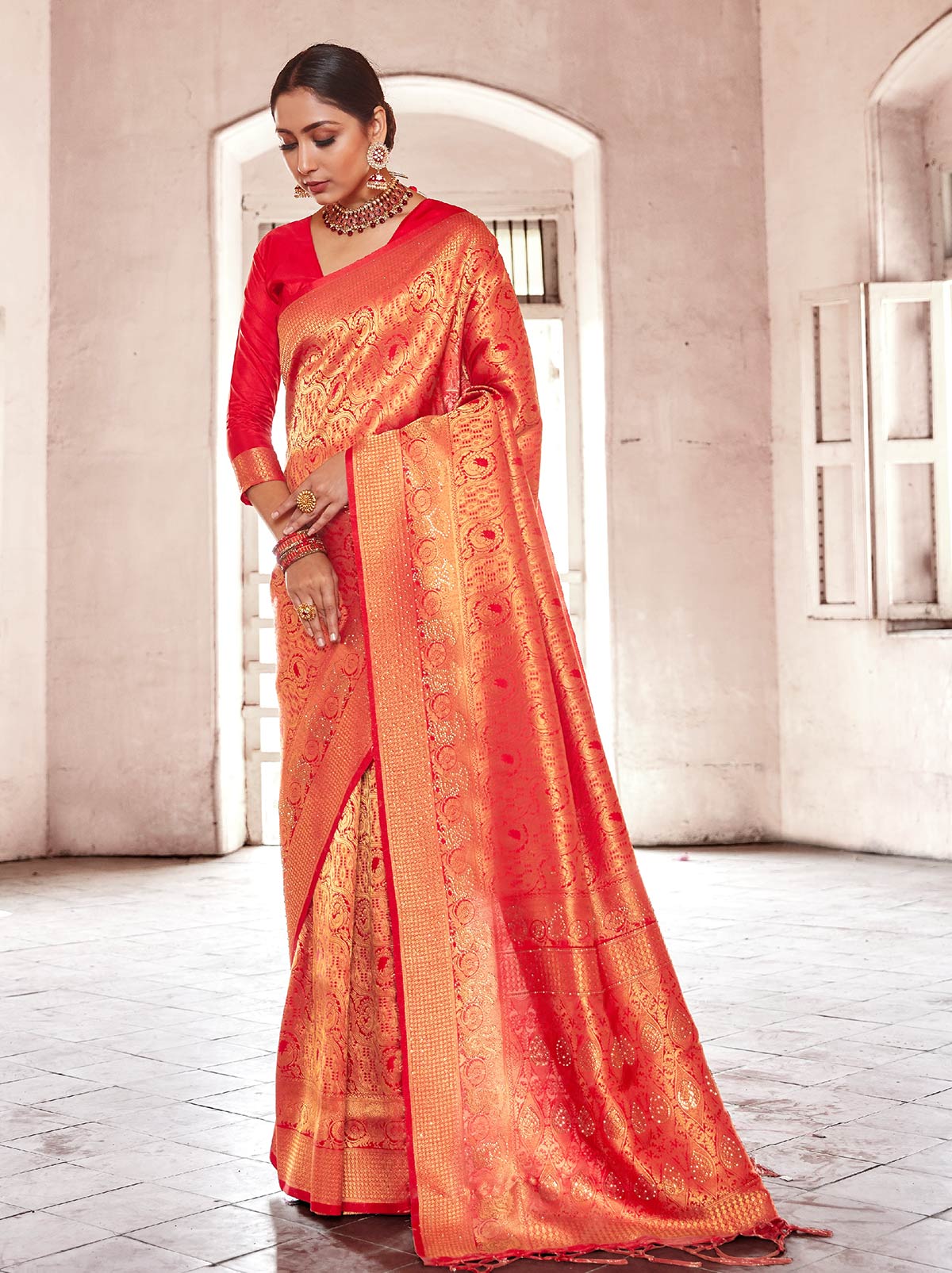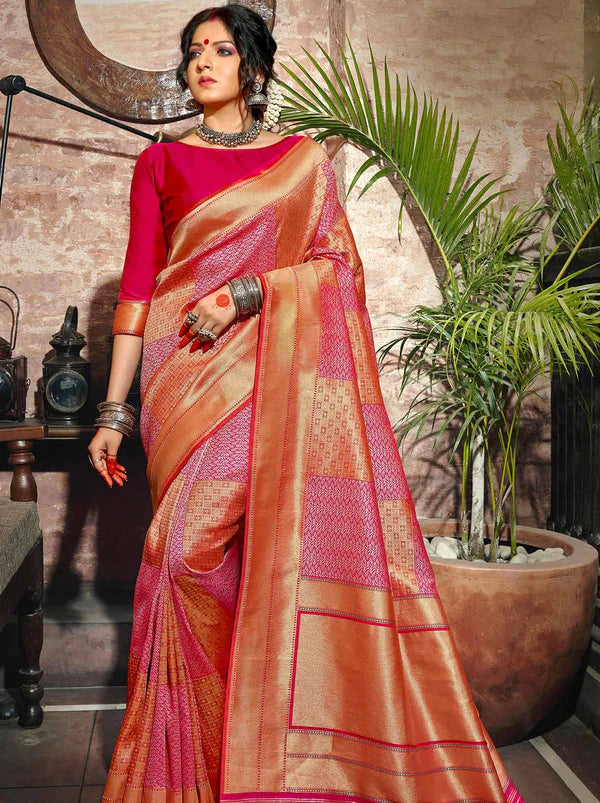Article: History, Origin And Developments In Saree Fashion

History, Origin And Developments In Saree Fashion
You have seen the modern versions and draping styles of the saree. But do you know the origin of sarees? How has it evolved through the ages? Find out here.
The saree or sari is a quintessential part of Indian culture and tradition. Sarees are a must-have elegant attire for women and are worn at weddings, parties, and festivals..
The word ‘saree’ or ‘sari’ is a Sanskrit word that means ‘a strip of cloth’. It is derived from the Prakrit word, sattika, which is mentioned in ancient Jain and Buddhist literature. With time, it took on the term ‘sati’ and eventually became known as ‘saree’.
The saree is worn by women of South Asian countries, like India, Pakistan, and Nepal, as an everyday and special occasion attire. But over the years, traditional Indian sarees have gained immense popularity in fashion industries across the world.
This most popular Indian attire is worn by women of all ages and at different stages of life. It has taken on quintessential representations of Indian traditional and feminine wear. But how did it come to be in the styles and forms of today? What is the saree drape origin? Let’s find out.
Origin of Sarees
The origin of sarees can be traced back thousands of years. In popular history, the birth of sarees dates back to ancient civilisations, with the Indus Valley cited as the first place to wear saree in the Indian subcontinent. The first mention of the saree is seen in the Rig Veda and the epics like Mahabharata and Ramayana.
What takes on highly fashionable forms today was originally just a humble, functional garment. According to most depictions, when sarees started , they were worn as unstitched pieces of cloth. It is believed that the drapes flourished during 2800 BC-1800BC across the Indian subcontinent. There is evidence of saree-like garments being worn by women in different parts of the world, but the draping style and silhouettes are different from what we see today.
Evolution of Saree
Various ancient Indian empires, including the Guptas, the Mauryas, the Mughals and even the British Raj, have contributed to the evolution of the saree. The form of the saree we see today was developed in the post-Mughal era. Under the influence of various cultures and traditions, different methods of weaving, dyeing and printing of fabric were developed.
Thus, every great epoch and dynasty has had a significant impact on the evolution of the saree. Let’s take a look at some of the key developmental changes of sarees:
- The origin of sarees was with the use of cotton, as the textile was prevalent at the time. But eventually, specifically during the pre-industrial times, silk was developed in China and later introduced in India through the Silk Road. This marked the origin of silk sarees.
- After industrialisation, synthetic dyes were used in the making of sarees. Around that time, different techniques of dyeing and printing were also developed.
- Stitching was introduced to India by the Greeks. It became so popular that eventually, every region of India developed a unique style of stitching.
- The Mughals brought traditional embroidery, embellishments and patterns to India. With the richness of the Mughal fabric and the intricate designs of the skilled Indian weavers, a dazzling variety of sarees was developed. The most famous among them was the Banarasi saree.
- The saree was worn without blouses and petticoats before the British Raj. But during the Victorian era, blouseless sarees were seen as improper. So, the British promoted wearing blouses and petticoats with the saree.
- Later, various types of regional handloom saris made of silk, ikkat, cotton, embroidery, block-print, and tie-dye textiles were developed. There has been a dramatic transformation in the use of fabric, motifs and embellishments for making sarees over a period.
- Today, in various parts of the country, sarees are worn not just for fashion but for daily use, too. Sarees are popularly touted as one of the most versatile and comfortable garments ever.
- With the development of the textile industry in India and increasing foreign influence, the saree became the first Indian garment to be recognised internationally.
Developmental Changes in Saree Fashion
The colour, design, fabric and pattern of a saree symbolise the traditions, conventions, beliefs and customs of the people wearing it in different parts of India. The confluence of many regional cultures, indigenous weaving, foreign influences, and production techniques have led to the development of very unique and different sarees. Some of them are described below.
The sensuality, grace, elegance, and traditional craftsmanship associated with Indian sarees have made them immensely popular across the globe. Many of the latest saree styles integrate modern aesthetics and western designs like digital prints, standout blouse patterns, and abstract motifs. Georgette, crepe and chiffon are some of the preferred fabrics for modern-day sarees.
- In earlier days, women used to wear a nine-yard saree only. Nowadays, they have several options, from a four-yard-long saree to a nine-yard one. Even today, women in the villages wear 9-yard-long festive sarees for worship and religious occasions.
- With the emergence of different styles of weaving, dyeing and printing, the skills of rural artisans and their handcrafted sarees have gained popularity worldwide. The designs, patterns and motifs on the saree are popularly inspired by religion or nature. With time, these handcrafted sarees have taken on special names like Patola sarees, Chanderi sarees, Chikankari sarees, and Paithani
- Silk variants of the saree, including Banarasi, Bagalpuri, Gadwal, Kanchipuram, Mysore, Uppada, Balchuri, Chanderi, Mekhela, Maheshwari, Paithani, Ghicha, Eri, Narayanpet, etc., have been developed in different Indian regions. Printed silk sarees, blended silk sarees, and designer and trendy silk sarees are other variants of the textile.
- Apart from the fabric and patterns, there are also different draping styles found across India. There are hundreds of draping styles that represent different regional conventions. In the most common style, the garment is wrapped around the waist, with the loose end of the drape worn over the shoulder. Various draping styles require different lengths of the saree.
The sensuality, grace, elegance, and traditional craftsmanship associated with Indian sarees have made them immensely popular across the globe. Many of the latest saree styles integrate modern aesthetics and western designs like digital prints, standout blouse patterns, and abstract motifs. Georgette, crepe and chiffon are some of the preferred fabrics for modern-day sarees.
You also have your pick of modern designer sarees that can jazz up the ethnic look of the garment. Designers have come up with stunning saree gowns, fancy saree pants, party sarees, t-shirt sarees and many other options that are a perfect blend of the traditional saree and today’s fashion trends. From heavily embellished bridal wedding wear to trendy designer styles, the appeal of the saree is unmatchable, and it finds favour amongst everyone and for every occasion!








Leave a comment
This site is protected by hCaptcha and the hCaptcha Privacy Policy and Terms of Service apply.